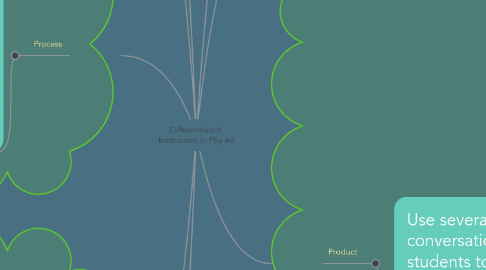
1. knowing how to modify and accommodate the needs of students
2. using a wide range of physical activity experiences with different pieces of equipment to support Health and Physical Education
3. identifying factors in a diverse and changing society that impact on the adolescent learner
4. Content
4.1. Help students identify areas of deficiency in movement skills and physical fitness while modifying the learning process to meet students’ needs; build on their strengths and provide multiple opportunities for formative assessment. LEARN, PRACTICE, DEMONSTRATE, More PRACTICE
5. Process
5.1. Use a variety of instructional strategies, effective questioning, and flexible groupings to ensure learning is appropriately outlined for each student. DI strategies such as Tiering or Cubing with station-centered activities provide choice and modifications for gradual skill building, in turn building confidence, increased motivation and movement competence
6. Learning Environment
6.1. Consider ways to create a student centered, physically and emotionally safe environment that is relevant to your students’ lives.
6.2. Get to know your students’ interests, previous experiences, and goals related to HPE.
6.3. Co-construct success criteria with your students to ensure the learning targets are clear and transparent to them.
6.4. Understand the context in which you are teaching so that you can be culturally relevant and responsive to your students’ needs
7. Product
7.1. Use several assessment strategies such as conversations, observations, or products for students to demonstrate what they know in a variety of ways.
7.1.1. assessment strategies
7.1.1.1. Conversations
7.1.1.1.1. Conference
7.1.1.1.2. Interview
7.1.1.1.3. Questioning
7.1.1.1.4. Small group discussions; e.g. think, pair, share; 2 stars and 1 wish
7.1.1.1.5. Large group discussions
7.1.1.1.6. Quick debriefs after a game or within a physical activity circuit
7.1.1.2. Observations
7.1.1.2.1. Observation of game sense in a game e.g., moving into open space to support team mate, communicating effectively to teammates
7.1.1.2.2. Student journals
7.1.1.2.3. Student/peer assessment of a movement skill or fitness skill using a 4 point checkbric – emerging, developing, competent, accomplished
7.1.1.3. Products
7.1.1.3.1. Physical demonstration of performance of a chosen movement skill or fitness skill
7.1.1.3.2. Video or audio recording
7.1.1.3.3. Photograph or series of photographs to demonstrate phases of a movement skill
7.1.1.3.4. Report
7.1.1.3.5. Presentation
7.1.1.3.6. Pamphlet or Public Service Announcement
